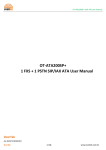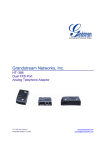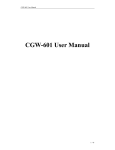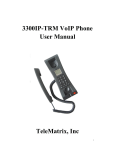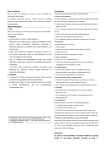Download AG198-User manual-W-V110721-En
Transcript
AG-188 User Manual AG-198 User Manual ISSUE 1.0 2011-07-21 1 / 40 AG-188 User Manual 1 AG-198 Features...................................................................................................... 4 1.1 Appearance.......................................................................................................................4 1.2 Interface.............................................................................................................................4 1.3 Electricity characteristic...................................................................................................5 1.4 Software.............................................................................................................................5 1.5 Standard and Protocols...................................................................................................5 1.6 Compliant Standards....................................................................................................... 6 1.7 Operating requirement.................................................................................................... 6 1.8 Package.............................................................................................................................6 1.9 Installation......................................................................................................................... 7 2 Web Configuration....................................................................................................7 2.1 Access Web setting page............................................................................................... 7 2.2 Current state..................................................................................................................... 8 At the bottom of the page, there shows firmware version................................................ 8 Version: VOIP Gateway V1.0.178.16 Jul 12 2011............................................................. 8 Network.................................................................................................................................... 9 2.2.1 Wan Config............................................................................................................ 9 2.2.2 LAN Config...........................................................................................................10 2.3 VoIP..................................................................................................................................10 2.4.1 SIP Config............................................................................................................ 10 2.4.2 Iax2 Config........................................................................................................... 13 2.4 Advance...........................................................................................................................15 2.4.1 DHCP Server....................................................................................................... 15 2.4.2 NAT....................................................................................................................... 16 2.4.3 Net Service...........................................................................................................17 2.4.4 QoS settings........................................................................................................ 18 2.4.5 Digital Map........................................................................................................... 19 2.4.6 Call Service......................................................................................................... 20 2.4.7 MMI Filter.............................................................................................................21 2.4.8 Audio Settings..................................................................................................... 22 2.4.9 Firewall.................................................................................................................23 2.4.10 VPN.................................................................................................................... 24 Dial-Peer Settings....................................................................................................................25 2.5 Config Manage............................................................................................................... 26 2.6 Update............................................................................................................................. 27 2.7 System Manage..............................................................................................................29 2.7.1 Account Manage.................................................................................................29 2.7.2 Syslog Config:.....................................................................................................29 2.7.3 Time Set:..............................................................................................................30 2.7.4 Logout&Reboot...................................................................................................30 3 IVR............................................................................................................................ 31 POST Mode(safe mode)...........................................................................................31 4 FAQ...........................................................................................................................34 2 / 40 AG-188 User Manual How many SIP servers may AG-198 register simultaneously?.............................34 How can I know the AG-198’s IP address?.............................................................. 34 How to use AG-198’s Lifeline function?.................................................................... 34 Why the settings vanish after reboot?.......................................................................34 How to use the dial rule?.............................................................................................34 How to use speed dial function?................................................................................ 36 How to configure digital map?.................................................................................... 36 How to use Call Transfer and 3-way Conference calls?........................................ 36 VLAN implement...........................................................................................................37 3 / 40 AG-188 User Manual 1 AG-198 Features 1.1 PWR PWR: SYS : WAN: LAN: PSTN: VoIP: 1.2 PWR WR:: Port: WAN: LAN: Appearance power connection status server registration status . registered: on , gliting , not-registered , off WAN port connectiong , contected , on , offline : off LAN port connectiong , contected , on , offline : off light on when PSTN call come in/out light on when VoIP call come in/out. Default to use VOIP to call out. Interface Output Power:12VDC,500mA. RJ11 port. Connect to handset or the Lifeline accessory. RJ45 port. RJ45 port. 4 / 40 AG-188 User Manual 1.3 � � � 1.4 Electricity characteristic Speciality of electric electric:: output the 12V 500mA DC The network connects: connects:2 RJ45 connect, a WAN, a LAN FXS: 2 port Software � � � � � � Support two sip servers running at the same time. NAT. DHCP client and server. Support PPPoE, (used for ADSL, cable modem connecting). Support major G7.xxx CODEC. VAD,CNG. � G.165 compliant 16ms echo cancellation � Tone generation and Local DTMF re-generation according with ITU-T � E.164 dial plan and customized dial rules � DTMF of inband audio, RFC2833 and SIP info etc. � Support Lifeline. � Hotline. � Speed Dial � � Call Forward, Call Transfer, 3-way conference calls Caller ID display � DND(Do Not Disturb),Black List,Limit List � � � � � Upgrade firmware through FTP or TFTP. Auto provision for config file. Web management. Reverse polarity Voice prompt � adjustable user password and admin password 1.5 � � � Standard and Protocols IEEE 802.3 /802.3 u 10 Base T / 100Base TX PPPoE: PPP Protocol over Ethernet DHCP Client and Server: Dynamic Host Configuration Protocol 5 / 40 AG-188 User Manual � � � � � � � � � � � � 1.6 G.711 u/a; G729 audio Codec SIP RFC3261, RFC 2543 IAX2 TCP/IP: Internet transfer and control protocol RTP: Real-time Transport Protocol RTCP: Real-time Control Protocol VAD/CNG save bandwidth DNS: Domain Name Server TFTP: Trivial File Transfer Protocol HTTP: Hyper Text Transfer protocol FTP: File Transfer protocol RFC 3362:T.38 protocol Compliant Standards � � � � CE:EN55024,EN55022 FCC part15 comply with ROHS in EU comply with ROHS in China � Explanation Explanation:: The letter “e” is the first letter of “environment: and “electronic”, The rim is a round with two arrow , stands for recycle. The number 20 stands for the years of environment protection. Please note the years of environment protection is not discarding year nor usage life 1.7 Operating requirement ● ● ● 1.8 � � Operation temperature: 0 to 40° C (32° to 104° F) Storage temperature: -30° to 65° C (-22° to 149° F) Humidity: 10 to 90% no dew Package Size 128 x 85 x 30 mm Packing List AG-198 gateway � Power adaptor (12v, 500mA) � Manual CD � 6 / 40 AG-188 User Manual 1.9 Installation Use Ethernet cable to connect AG-198’s LAN port and your computer. Set your computer’s ip to the network 192.168.10.x or using dynamic obtain IP. Open your web browser and key in 192.168.10.1. Then you will see the logon page of AG-198, the default username and password is admin/admin for administrator and guest/guest for guest. Set up page for VoIP use only: Internet PBX Power PSTN U ser PO S Phone 2 Web Configuration 2.1 Access Web setting page Enter AG-198 IP address in the web browser and press ENTER to go to the log on page, and key in the username and password to access AG-198 setting page. Default username and password is: Administrator: Username: admin password: admin User: Username: guest Username: guest 7 / 40 AG-188 User Manual 2.2 Current state This page shows AG-198’s running state. Network :shows the WAN and LAN port connecting state and current settings. : show the default protocol, the working state of SIP and IAX2, you can see whether VoIP VoIP: AG-198 has registered the public sip server and IAX2 server. Phone Number shows the public sip server、 the private sip server and the IAX2 server phone numbers. At the bottom of the page, there shows firmware version. Version: VOIP Gateway V1.0.178.16 Jul 12 2011 8 / 40 AG-188 User Manual Network 2.2.1 Wan Config WAN support static IP, dynamic obtain IP and PPPoE.Default to use DHCP. � Configure Static IP: ----Enable Static; ----Set AG-198’s IP address in the IP Address; ----Set net mask in the Net mask field; ----Set router IP address in the Gateway; ----DNS Domain: ----Set local DNS server in the Preferred DNS and the Alternate DNS � Configure to dynamic obtain IP ----Enable DHCP; If there is DHCP server in your local network, AG-198 will automatically obtain WAN port network information from your DHCP server. � Configure PPPoE: ----Enable PPPoE ----PPPoE server: Enter “ANY” if no specified from your ITSP. ----Enter PPPoE username and pin in the username and password. AG-198 will automatically obtain WAN port network information from your ITSP if PPPoE setting and the setup are correct. Notice: If user accesses the gateway through WAN port. He should use the new IP address to access AG-198 when the WAN port address was changed. 9 / 40 AG-188 User Manual 2.2.2 LAN Config IP , Netmask Netmask:: Set the IP and Netmask for the LAN DHCP Server: Enable DHCP service in LAN port NAT: Enable NAT. Bridge Mode: Enable this option to switch to bridge mode. Gateway won’t assign IP for its LAN port in bridge mode and its LAN and WAN port will be in the same network. (This setting won’t take effect unless you save the config and reboot the device) 2.3 VoIP 2.4.1 SIP Config � SIP Line Select: AG-198 support 2 sip line. You can select SIP1 or SIP2 in the drop down box, and press Load to switch. � Basic Setting: � Register Status: Shows wether the sip account registered successfully � Server Name: Keep it as blank if no specific 10 / 40 AG-188 User Manual � � � � � � � � � � � � � � � � � Register Server Addr: Register address of public SIP server Register Server Port: Register port of public SIP server Account Name: Username of your SIP account Password: Password of your SIP account Phone number: Set phone number the same as Account Name Display Name: Name displayed as Caller ID. If server has set the Caller ID,your Caller ID will be the one which set by server not by phone. Proxy Server Addr: IP address of proxy SIP server (SIP provider always use the same IP for register server and proxy server, in this case you don’t need to configure the proxy server information. ) Proxy Server Port: Signal port of SIP proxy Proxy Username: proxy server username Proxy Password: proxy server password Domain Realm: SIP domain, enter the sip domain if any, otherwise AG-198 will use the proxy server address as sip domain Enable Register: Enable register or disable register Advanced Set: Register Expire Time: Register expire time, default is 60 seconds. AT-640 will auto configure this expire time to the server recommended setting if it is different from the SIP server. NAT Keep Alive Interval: Set examining interval of server, default is 60 seconds. If the phone has enabled Nat Keep Alive, the phone will detect server after interval to check if the server has response. User Agent: Set the user agent if have, the default is VoIP Phone 1.0. DTMF Mode: Select DTMF sending mode, there are three modes: 11 / 40 AG-188 User Manual � � � � � � � � � � � � � � � � � � � � � � � � � � � � � � DTMF_RELAY DTMF_RFC2833 DTMF_SIP_INFO Different VoIP Service providers may provide different modes. Media Key: voice stream encryption Key. Local Port: Local SIP signal port,default as 5060. RFC Privacy Edition: Set privacy protocol. Transfer Expire Time: Transfer expire time set. Enable Keep Authentication: Enable/Disable Keep Authentication System will take the last authentication field which is passed the authentication by server to the request packet. It will decrease the server’s repeat authorization work, if it is enable. NAT Keep Alive: If the phone has enabled Nat Keep Alive, the phone will detect server after interval to check if the server has response. Enable Via rport: Enable/Disable system to support RFC3581. Via rport is special way to realize SIP NAT. Enable PRACK: Enable or disable SIP PRACK function, suggest use the default config. Long Contact: Set more parameters in contact field. Enable URI Convert: convert # into %23 when sending URI. Dial Without Register: Set call out by proxy without registration. Ban Anonymous Call: Set to ban Anonymous Call. Forward Type: Select call forward mode, the default is Off . Off:Close down calling forward. Busy:If the phone is busy, incoming calls will be forwarded to the appointed phone. No answer:If there is no answer, incoming calls will be forwarded to the appointed phone. Always:Incoming calls will be forwarded to the appoint phone directly. The phone will prompt the incoming while doing forward. Forward Phone Number: Appoint your forward phone number. Server Type: Select the special type of server which is encrypted, or has some unique requirements or call flows. Subscribe Expire Time: Overtime of resending subscribe packet. Suggest using the default config. RFC Protocol Edition: Select SIP protocol version to adapt for the SIP server which uses the same version as you select. For example, if the server is CISCO5300, you need to change to RFC2543; else phone may not cancel call normally. System uses RFC3261 as default. Transport Protocol: Set transport protocols, TCP or UDP. MWI Number: Set SIP1 voicemail Number. Enable DNS SRV: Enable DNS Enable Subscribe: Enable Subscribe: Overtime of resending subscribe packet. Suggest using the default config. Rtp Encode: enable voice data encryption. Enable Session Timer: enable rfc4028 to refresh the SIP sessions. 12 / 40 AG-188 User Manual � � � � � Answer With Single Codec: only answer the call with a certain Codec. Auto TCP: enable TCP transmission protocol when the length of message exceed 1300 byte Enable Strict Proxy: Support the special SIP server-when phone receives the packets sent from server, phone will use the source IP address, not the address in via field. Enable GRUU: Set to support GRUU. Enable Displayname Quote: Set to make quotation mark to display name as the phone sends out signal, in order to be compatible with server. 2.4.2 Iax2 Config IAX2 Server Addr: Register address of public IAX server 2 Server Port: Register port of public IAX server, default port is 4569 IAX IAX2 Account Name: Username of your SIP account (Always the same as the phone number) Account Password: Password of your IAX account Local port: Signal port of local, default port is 4569 Phone Number: Phone number of your IAX account Voice mail number: If the IAX support voice mail, but your username of the voice mail is letters which you can not input with the ATA , then you use the number to stand for your username Voice mail text: if IAX support voice mail, config the domain name of your mail box here. Echo test number: If the platform support echo test , and the number is test form , the config the test number to replace the text format The echo test is to test the woring status of terminals and platform Echo test text: echo test number in text format Refresh time: IAX refresh time Enable Register: enable or disable register 13 / 40 AG-188 User Manual IAX(Default Protocol): Set IAX 2 as the default protocol , if not the system will choose SIP as default Enable G.729: Using G.729 speech coding mandatory consultations 14 / 40 AG-188 User Manual 2.4 Advance 2.4.1 DHCP Server User may trace and modify DHCP server information in this page. DHCP Leased Table: show existed DHCP lease table. DHCP Lease Table setting: User may use below setting to add a new lease table. � Lease Table Name: Lease table name. � Start IP: Start IP of lease table. � End IP: End IP of lease table. Network device connecting to the AG-198 LAN port can dynamic obtain the IP in the range between start IP and end IP. � Lease Time: DHCP server lease time. � Netmask: Netmask of lease table. � Gateway: Default gateway of lease table. � DNS: default DNS server of lease table. DHCP Lease Table Delete: Delete existed lease table. DNS Relay: enable DNS relay function. Notice: This setting won’t take effect unless you save the config and reboot the device 15 / 40 AG-188 User Manual 2.4.2 NAT Advance NAT setting. Maximum 10 items for TCP and UDP port mapping. IPSec ALG: Enable/Disable IPSec ALG; FTP ALG: Enable/Disable FTP ALG; PPTP ALG: Enable/Disable PPTP ALG; Transfer Type: Transfer type using port mapping. Inside IP: LAN device IP for port mapping. Inside Port: LAN device port for port mapping. Outside Port: WAN port for port mapping. Click Add to add new port mapping item and Delete to delete current port mapping item. 16 / 40 AG-188 User Manual 2.4.3 Net Service HTTP Port: configure HTTP transfer port, default is 80.User may change this port to enhance system’s security. When this port is changed, please use http://xxx.xxx.xxx.xxx:xxxx/ to reconnect. RTP Initial Port: RTP initial port. RTP Port Quantity: Maximum RTP port quantity, default is 200 Notice: Settings in this page won’t take effect unless save and reboot the device. If you need to change telnet port or HTTP port, please use the port greater than 1024, because ports under 1024 is system remain ports. HTTP service if HTTP is set to 0. 17 / 40 AG-188 User Manual 2.4.4 QoS settings AG-198 implement QoS based on 802.1p, The QoS is used to mark the network communication priority in the data link/MAC sub-layer. AG-198 will sorted the packets using the QoS and sends it to the destination. 1. Voice 802.1p Priority --- Configure the priority of the voice packets in 802.1p protocol. 2. VLAN Enable --- Disable/Enable VLAN function 3. Voice VLAN ID 4. DiffServ Enable --- Disable/Enable Diffserv service 5. DiffServ Value --- Configure Diffserv parameter. The value range : value range: --- configure the Voice/signaling VLAN ID 0x28,0x30,0x38,0x48,0x50,0x58,0x68,0x70,0x78,0x88,0x90,0x98,0xb8.default is 0xb8 ,oxb8 stands for best fast transmission; 28-30 is guaThrantee for the transmission priority for the 1st rank , 48-58 is guarantee for the transmission priority for the 2nd rank, 68-78 is guarantee for the transmission priority for the 3rd rank, 88-98 is guarantee for the transmission priority for the 4th rank. 6. Data VLAN ID--- Assign VLAN id for data stream. 7. Data 802.1P Priority --- Configure the priority of the data packets (non-voice/signaling data) in 802.1p protocol. 8. Data/Voice DiffServ differentiated --- undifferentiated for Date and voice VLAN is not distinction VLAN tag, Tag differentiated for Date and Voice VLAN is distinction VLAN tag, Date untagged for Date VLAN is distinction VLAN tag Please refer to VLAN implement for detail 18 / 40 AG-188 User Manual 2.4.5 Digital Map Digit map is a set of rules to determine when the user has finished dialing. AG-198 support below digital map: Digital Map is based on some rules to judge when user end their dialing and send the number to the server. AG-198 support following digital map: ----End With “#”: Use # as the end of dialing. ----Fixed Length: When the length of the dialing match, the call will be sent. ----Timeout: Specify the timeout of the last dial digit. The call will be sent after timeout ----Prefix: User define digital map: [ ] represents the range of digit, can be a range such as [1-4], or use comma such as [1,3,5], or use a list such as [234] x represents any one digit between 0~9 Tn represents the last digit timeout. n represents the time from 0~9 second, it is necessary. Tn must be the last two digit in the entry. If Tn is not included in the entry, we use T0 as default, it means system will sent the number immediately if the number matches the entry. Example: [1-8]xxx All number from 1000 to 89999 will be sent immediately. 9xxxxxxx 8 digits numbers begin with 9 will be sent immediately. 911 Number 911 will be sent will be immediately 99xT4 3 digits numbers begin with 99 with be sent after four seconds. 19 / 40 AG-188 User Manual 2.4.6 Call Service User configure the value add service such as hotline, call forward, call transfer, 3-way conference call .etc in this page Call Service Setting: � Hotline: configure hotline number. AG-198 will immediately dials this number after hook-off if it is set. � Warm Line Time: configure warm line time, if you pick up the phone, the number will be send out after the time. � P2P IP Prefix: Set ip prefix. For example, you set prefix as 192.168.1.,then you can dial #200# to call the phone which ip is 192.168.1.200. � No Answer Time: no answer call forward time setting � Do Not Disturb: DND, enable this option to refuse any calls. � Accept Any Call: If this option is disable, AG-198 refuse the incoming call when the called number is different from AG-198’s phone number. � � Enable Call Transfer: Please refer to value add service for detail. Ban Outgoing: Enable this to ban outgoing calls. � Enable Three Way Call: Please refer to value add service for detail. � Enable Call Waiting: Enable/disable Call Waiting Black List: incoming call in these phone numbers will be refused. Limit List: outgoing calls with these phone numbers will be refused 20 / 40 AG-188 User Manual 2.4.7 MMI Filter MMI filter is used to make access limit to AG-198 Gateway. When MMI filter is enable. Only IP address within the start IP and end IP can access AG-198 gateway. 21 / 40 AG-188 User Manual 2.4.8 Audio Settings � � � � � � � � � � CODEC: select the prefer CODEC; support G711A, G711U, G729 and G726-32 Output Volume: Handset out volume Dtmf Payload Type: Choose dtmf payload type G729 Payload Length: G729 payload length Signal Standard: Support Australia, Brazil, China, Czech, Israel, Japan, South Korea, UK and USA standard CallerID Tx Mode: Support Bellcore FSK(US), Brazil DTMF(BR), ETSI FSK(UK) and ETSI DTMF(UK) FAX Mode: Support T.38,BYPASS-A and BYPASS-U Flashhook Min Time: Set the minimum Flashhook time Flashhook Max Time: Set the maximun Flashhook time VAD: Enable/disable Voice Activity Detection 22 / 40 AG-188 User Manual 2.4.9 Firewall � � � � � � � � � � � � In_access Enable: Select it to Enable in_ access rule. Out_access enable: Select it to Enable out_ access rule. Firewall Input Rule Table: Firewall input rule Firewall Output Rule Table: Firewall output rule Input/output: Specify current adding rule by selecting input rule or output rule. Deny/Permit: Specify current adding rule by selecting Deny rule or Permit rule. Protocol Type: Filter protocol type. You can select TCP, UDP, ICMP, or IP. Port Range: Set the filter Port range. Src Addr: Set source address. It can be single IP address, network address, complete address 0.0.0.0, or network address similar to *.*.*.0. Dest Addr: Set the destination address. It can be IP address, network address, complete address 0.0.0.0, or network address similar to *.*.*.*. Src Mask: Set the source address’ mask. For example, 255.255.255.255 means just point to one host; 255.255.255.0 means point to a network which network ID is C type. Des Mask:: Set the destination address’ mask. For example, 255.255.255.255 means just point to one host; if set to 255.255.255.0 means point to a network which network ID is C type. 23 / 40 AG-188 User Manual 2.4.10 VPN This is VPN setting page , the Gateway support the VPN with L2TP protocol .The parameters is as below : After VPN registered successfully, VPN server will give an IP aggress to the VPN IP IP: terminal . If there is a IP address shown on terminal (except for 0.0.0.0) ,it means your VPN has registered VPN Mode: Only support L2TP VPN(without IPSec) and whether to enable VPN. L2TP VPN Settings: � VPN Server Addr: register to the address of VPN server � VPN User Name: L2TP VPN username � VPN Password: L2TP VPN password 24 / 40 AG-188 User Manual Dial-Peer Settings Please refer to “how to use dial rule?” for detail. 25 / 40 AG-188 User Manual 2.5 Config Manage Save Config: save current settings. Backup Config: left click,you will see the config.txt file. Right click it you can save the file. Clear Config: restore to default settings. Notice: clear config in admin mode, all settings restores to factory default; clear config in guest modem, all settings except sip, advance sip restore to factory default. 26 / 40 AG-188 User Manual 2.6 Update 2.8.1 Web Update: update gateway’s settings or firmware. Firmware file is .z extension when configure file is .txt extension, AG-198 will auto select configure update or firmware update according the extension. 2.8.2 /TFTP Update: FTP FTP/TFTP Update the firmware or config.txt file by FTP/TFTP, or export config.txt file to your computer by FPT/TFTP. 27 / 40 AG-188 User Manual 2.8.3 Auto update: AG-198 gateway support FTP and TFTP auto update. The gateway will auto obtain the configure file from your update server if configured. To obtain the original configure file, you can use the FTP/TFTP back up as describe above. Configure file using module structure, user may remain the concerned modules and remove other modules. Put the configure file in the root directory of update serve when finish editing. � � � � � � � � � � � � Current Version: the system will display the current version number 。 Server Address: FTP/TFTP server address Username: FTP server user name Password: FTP server password Config File Name: The name of configuration file Config Encrypt Key: The encrypt key of confirmation file Protocol Type: The protocol type that used for upgrading Update Interval Time: The interval time that the terminals search for new configuration file. Update Mode: auto provision mode Disable: not auto update Update after reboot: auto update after reboot Update at time interval: auto update after update interval time 28 / 40 AG-188 User Manual 2.7 System Manage 2.7.1 Account Manage There are two User Level: � Root: as administer,can configure all the items � General: as guest, can only check the status and change network. 2.7.2 Syslog Config: Server IP: set the syslog server address Server Port: set the syslog server port MGR Log Level: set the MGR log level SIP Log Level: set the SIP log level IAX2 Log Level: set the IAX2 log level Please click “apply” after setting 29 / 40 AG-188 User Manual 2.7.3 Time Set: Server:type the ip address of time server Timezone:select correct time zone in list box Timeout: longest response time for SNTP Manual Timeset:The time setting Daylight: Daylight Saving time NTP: enable NTP time server 2.7.4 Logout&Reboot Reboot Gateway, some setting needs to reboot to make it works. Please always save config before reboot, otherwise the setting will return to previous setting. 30 / 40 AG-188 User Manual 31 / 40 AG-188 User Manual 3 IVR User may pre-config AG-198 gateway using a normal phone connecting to AG-198. please refer the below command: Notice: all command below can be end with # to speed response. "#****" "#*000" /*reboot gateway*/ /*clear settings*/ "#*100" "#*101" "#*102" /*set the IP type to static ip */ /*set IP type to DHCP */ /*set IP type to PPPoE*/ "#*111" "#*222" /*prompt gateway ip*/ /* prompt phone number*/ Below setting need reboot to take effect "#*103" /*change to bridge mode*/ "#*104" /*change to router mode*/ "#*50192.168.1.117" set WAN port IP address "#*51192.168.1.1" set default gateway IP "#*52202.112.10.37" set dns server "#*53255.255.255.0” set netmask, use 255.255.255.0 if no be set POST Mode(safe mode) AG-198 provide safe mode. When there is booting problem because of setting problem or firmware problem. User can restore the factory setting or upgrade to a new firmware to solve this problem. STEPS: 1. Download nc folder and save it on your computer 2. Connect your PC to the Lan port of AG-198, AG198 LAN ip is 192.168.10.1, and set your computer ip as 192.168.10.X 3. Power up AG-198 and long-press "reset" key (beside PWR) immediately for 10s. 4. Run CMD on your computer 32 / 40 AG-188 User Manual 5. Enter the folder which you save nc,for example I save it in disk E, so type e: and enter nc, connect nc with command "nc -u -v -s hostIp -p 6666 -n ataIp 6666". For example, my computer ip is 192.168.10.31,and press enter several times until you can see POST Menu. Then if you want to update firmware, you can act as following: 33 / 40 AG-188 User Manual Then update start Now update finished! 34 / 40 AG-188 User Manual 4 FAQ How many SIP servers may AG-198 register simultaneously? AG-198 support 2 SIP servers and a IAX server. The Default server is SIP . If you want to use the IAX server you must set IAX as default protocol in the IAX config page. IAX and SIP can register simultaneously but not work simultaneously. If you set 2 SIP servers in the SIP setting page , you can choose the route (server) by dialing plan which is edited by you. Please see “How to use the dial rule?” for detail. How can I know the AG-198 AG-198’’s IP address? Pick up the handset and then dial “#*111#”, and the AG-198 will promote you its IP address. How to use AG-198 AG-198’’s Lifeline function? AG-198 supports Lifeline function, you can use the same handset to place PSTN and VoIP calls. First, you need to connect PSTN line to AG198's PSTN port,connect a analog phone to Phone port. Then you can receive voip call and pstn call, and call default by sip. If you want to call by pstn, you can dail * to switch to pstn mode. If you want to replace the * rule, you need to set up as follow: ----Delete * rule in Digital Map( Advance->Digital Map), and add another rule,for example:1 ----Delete * rule in Dial Peer and add a new dial rule: set the phone number as 1, and choose the Lifeline as the Call mode.Then apply. Then when you want to place a PSTN calls, you can first press 1 to switch to the PSTN line and then place your call as you normal do. Why the settings vanish after reboot? Please go to Config Manage�Save Config to save your setting always. How to use the dial rule? AG-198 provide flexible dial rule, with different dial-rule configure, user can easily implement the following function: ----Replace, delete or add prefix of the dial number. ----Make direct IP to IP call ----Place the call to different SIP server according the prefix. ----Make PSTN calls use Lifeline function (Please refer “How can use the Lifeline function of AG-198?”). You can click “Add” to add a new dial rule. Below is the detail setting of the dial-rule: Phone Number: The Number suit for this dial rule, cam be set as full match or prefix match. Full match means that if the number user dialed is completely the same as this number, the call will use this dial-rule. Prefix match means that if prefix of the number that the user dials is the same as the prefix, the call will use this dial-rule, to distinguish from the full match case, you need to add “T” after the prefix number in the phone number 35 / 40 AG-188 User Manual setting. Call Mode: support SIP, IAX2 and Lifeline,SIP means the call will use sip protocol, IAX2 means the call will use iax2 protocol, Lifeline means the call will use the PSTN line. Destination (optional): call destination, can be IP or domain. Default is 0.0.0.0, in this case the call will be routed to the Public SIP server. If you set the destination to 255.255.255.255, then the call will be routed to the private SIP server. Also you can key other address here to make direct IP calls Port (optional): Configure the port of the destination, default is 5060 Alias (optional): (optional):Set up the Alias. We support four Alias as below. Alias need to co-work with the Del Length: � add:xxx, add prefix to the phone number, can set to reduce the dial length. � all: xxx, replace the phone number with the xxx, can use as speed dial function. � del, delete the first N numbers. N is set in the Del Length � rep:xxx,replace the first N numbers. N is set in the Del Length. For Example: Use wants to place a call 8610-62281493, then you can set the phone number in the dial rule as 010T, and set the Alias as rep:8610, and set the Del Length to 3. Then all calls begin with 010 will be changed to 8610 xxxxxxxx. Suffix (optional): (optional):Configure suffix, show no suffix if not set Instance: 2T rule rule: If the call starts with 2, the first 2 will be deleted, and the rest number will be sent to private server. 3T rule rule: If the call starts with 3, the first 3 will be deleted, and the rest number with be sent to public server. 123 rule rule: Dial 123 and will send 8675583018049 to your server. Used as speed dial function. 0T rule rule: If the calls is begin with 0, the first 0 will be replace by 86. Means that if you dial 075583018049 and AG-198 will send 8675583018049 to your server. *T rule rule: Dial the * and the line with switch to PSTN. Note that you need to set another rule “Prefix Number: *; Length: 1” in the Digital Map. (Refer “How to use AG-198’s Lifeline 36 / 40 AG-188 User Manual Function?”) 179 rule rule: when you dial 179 , the call with send to 192.168.1.179, suit for LAN application without set up a sip server. How to use speed dial function? Please refer to “How to use dial rule?”. How to configure digital map? Please refer digit map settings. How to use Call Transfer and 3-way Conference calls? User may set up the configuration in the Call Service page to use these value add service. � Call Transfer: Check the Enable Call Transfer. If A is the AG-198 user, and B calls and talking with A through VoIP. A can press the Hook-Flash to hold the call with B, and then press * and then enter C’s number number. B will be transferred to C and can talk with C. � 3-Way Conference Calls Check the Enable Three Way Call Only sip protocol support this function .Assume A is the AG-198 user, and B calls and talking with A through VoIP. A can press Hook-Flash to hold the call with B, then enter C’s number to talk with C, and then press Hook-Flash again switch back to user B , then A can press * to make 3-way conference calls. Notice: A can press Hook-Flash to switch between B and C. or press # to cancel the 37 / 40 AG-188 User Manual current call and switch to the other user. VLAN implement AG-198 support rich 802.1Q/P protocol and Diffserv configuration. Through its flexible VLAN function, you can set the voice/signaling and data packets in different VLAN via different VLAN id. Different implement of VLAN function: 1: if “Data/Voice VLAN differentiated” is undifferentiated. Device will set the same vlan ID for voice and data. As show below Or 2. if “Data/Voice VLAN differentiated” is Tag differentiated but the DiffServ is disable. Device won’t distinguish the voice, signaling and data stream. It will add the same data vlan id to them. As below: 38 / 40 AG-188 User Manual Or 3. if “Data/Voice VLAN differentiated” is Tag differentiated and diffServ are both enable. Then device will distinguish the voice, signaling and data stream to VLAN ID setting. As below: 39 / 40 AG-188 User Manual Or 4.if “Data/Voice VLAN differentiated” is Date untaged and diffServ are both enable. Then device will undistinguish the date to VLAN ID setting. As below: 5. if VLAN is disable. Device won’t add any vlan ID to the stream. In this case, if the Diffserv is enable, the DiffServ value response to the voice/signaling stream. 6. When VLAN function is enable. If “VLAN ID check” is enable, AG-198 will have strict requirement on the VLAN, it won’t handle any packets with different VLAN ID. If “VLAN ID check” is disable, AG-198 will handle the packets even from different vlan ID. Please notice that VLAN ID check is enable in default. 40 / 40










































